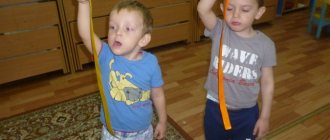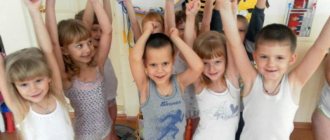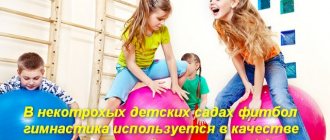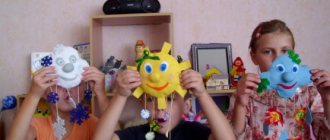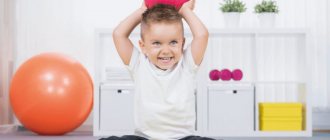Breathing exercises for preschool children
Breathing is the most important function of the body. An important place in physical culture is occupied by special breathing exercises, which provide complete drainage of the bronchi, cleanse the mucous membrane of the respiratory tract, and strengthen the respiratory muscles. Even the ancient eastern sages, the creators of various respiratory systems, attached great importance to breathing exercises. It was believed that in addition to oxygen supply, breathing also provided energy to the body. Proper breathing regulates the state of the human nervous system.
Recently, in many children's institutions, there has been an increase in the number of children with various developmental disorders, learning difficulties, and adaptation difficulties. Such children are disinhibited, often aggressive for no reason, and are unable to independently suppress negative emotions or control their soul and body. To overcome their existing disorders, one of the most important components is a system of breathing exercises, breathing exercises. Any person, be it a child or an adult, can do without food or water for some time, but without air he cannot live even ten minutes.
The habit of breathing through the mouth is harmful and leads to diseases of the thyroid gland and respiratory system. Nasal breathing protects the throat and lungs from cold air and dust, ventilates the lungs and middle ear cavity well, and has a beneficial effect on the blood vessels of the brain. In addition, such gymnastics significantly increases the strength of the protective mechanisms that protect the brain from insufficient blood supply.
Regular breathing exercises help to develop correct speech breathing with long, gradual inhalations and prevent respiratory diseases. Diseases such as rhinitis, nasopharyngitis, rhinosinusitis, sinusitis, chronic bronchitis, adenoiditis, nasal polyps often cause sound pronunciation in children, complicate the process of correct speech breathing, change the intonation color of the voice, and cause changes in the structure of the organs of articulation.
There are many methods of breathing exercises known (according to K. P. Buteyko, A. N. Strelnikova, according to the yoga system, etc.)
, but mechanically following any of them is not advisable.
The fitness of the respiratory muscles determines a person’s physical performance and endurance: as soon as an untrained person runs a few tens of meters, he begins to breathe rapidly and feel shortness of breath due to the poor development of the respiratory muscles. Trained people do not experience shortness of breath, and their breathing quickly calms down even after prolonged physical activity.
Regular breathing exercises will allow children not only to feel better, but also to conduct dialogue correctly using punctuation and expressiveness of speech. Because, often, children do not monitor their speech: they do not swallow drool, speak quickly, without emotions.
Also, many kindergartens have a swimming pool. And if we start morning exercises every day with breathing exercises, this will allow our children to breathe correctly when they swim.
When developing breathing exercises, I took into account:
- the effectiveness of each exercise for hardening and improving the health of children in a preschool institution;
— an accessible degree of difficulty of exercises for children of different ages;
- the degree of influence of exercises on strengthening the respiratory muscles, ventilation of all parts of the lungs, development of the upper respiratory tract, etc.
In order to systematically use breathing exercises, they should be included in complexes of health-improving gymnastics and physical education classes.
Approximate gymnastics complexes:
Let's listen to our breathing
Target:
teach children to listen to their breathing, determine the type of breathing, its depth, frequency and, based on these signs, the state of the body.
Starting position - standing, sitting, lying down (as convenient at the moment)
.
In complete silence, children listen to their own breathing and determine:
- what part of the body moves when inhaling and exhaling (stomach, chest, shoulders or all parts - wave-like)
;
- what is the breathing frequency: often inhale-exhale or calmly with a certain interval (automatic pause)
;
- quiet, inaudible breathing or noisy breathing.
This exercise can be done before or after physical activity, so that children learn to determine the state of the whole body by breathing.
Breathe quietly, calmly and smoothly
Starting position - standing, sitting, lying down (this depends on the previous physical activity)
. If you are sitting with your back straight, it is better to close your eyes.
Inhale slowly through your nose. When the chest begins to expand, stop inhaling and pause as long as you can. Then exhale smoothly through the nose (repeat 5–10 times)
.
The exercise is performed silently, smoothly, so that even a palm placed to the nose does not feel the stream of air when exhaling.
Balloon in the chest
(medium, costal breathing)
Starting position - lying, sitting, standing. Place your hands on the lower part of the ribs and concentrate on them.
Exhale slowly, evenly, squeezing the ribs of the chest with your hands.
1. Slowly inhale through your nose, your hands feel the expansion of your chest and slowly release the clamp.
2. As you exhale, the chest is again slowly pressed with both hands at the bottom of the ribs.
Repeat 6-10 times.
Balloon rises up (upper breathing)
Starting position - lying, sitting, standing. Place one hand between your collarbones and concentrate on them and your shoulders.
Inhale and exhale with a calm and smooth rise and fall of the collarbones and shoulders.
Repeat 4-8 times.
Wind
(cleansing, full breath)
Starting position - lying, sitting, standing. The torso is relaxed. Exhale completely through your nose, drawing in your stomach and chest. Take a full breath, protruding your stomach and chest ribs. Forcefully release the air through pursed lips with several abrupt exhalations.
Repeat 3-4 times.
Hedgehog
Turn your head left and right at the pace of movement. Simultaneously with each turn, inhale through the nose: short, noisy (like a hedgehog)
, with tension in the muscles of the entire nasopharynx
(the nostrils move and seem to connect, the neck tenses)
. Exhale softly, voluntarily, through half-open lips.
Repeat 4-8 times.
Lips “tube”
1. Exhale completely through the nose, drawing in the stomach and intercostal muscles.
2. Form your lips into a “tube” and sharply draw in air, filling all your lungs to capacity.
3. Make a swallowing movement (as if you are swallowing air)
.
4. Pause for 2-3 seconds, then raise your head up and exhale air through your nose smoothly and slowly.
Repeat 4-6 times.
Ears
Shaking your head left and right, take deep breaths. The shoulders remain motionless, but when the head is tilted to the right, the ears are as close to the shoulders as possible. Make sure that your torso does not turn when you tilt your head. Inhalations are performed with tension in the muscles of the entire nasopharynx. Exhalation is voluntary. Repeat 4-5 times.
Blowing soap bubbles
1. When tilting your head to your chest, inhale through your nose, straining the muscles of the nasopharynx.
2. Raise your head up and calmly exhale air through your nose, as if blowing soap bubbles.
3. Without lowering your head, inhale through your nose, straining the muscles of the nasopharynx.
4. Exhale calmly through the nose with your head bowed. Repeat 3-5 times.
Tongue "tube"
1. The lips are folded in a “tube”, as when pronouncing the sound “o”. Stick out your tongue and also fold it into a “tube”.
2. Slowly drawing in air through the “tube” of the tongue, fill all the lungs with it, inflating the stomach and ribs of the chest.
3. When you finish inhaling, close your mouth. Slowly lower your head until your chin touches your chest. Pause - 3-5 seconds.
4. Raise your head and calmly exhale air through your nose.
Pump
1. Bring your hands together in front of your chest, clenching your fists.
2. Bend forward and down and with each springy tilt take gusty breaths, as sharp and noisy as when inflating tires with a pump (5-7 springy bends and breaths)
.
3. Exhalation is voluntary.
Repeat 3 times.
Smelling flowers (exercises for younger children)
1. Hands in front of you, clenched into a fist, imagine that there is a chamomile in one hand and a dandelion in the other. On “one” - children smell chamomile, on “two” - they blow off a dandelion
2. Starting position - main stance. On “one” - children squat, collecting as many flowers as possible, on “two” - they sharply blow off all the flowers.
These exercises will allow children to breathe correctly during all physical activity and become resilient children!
Literature:
1. Gorbatenko O. F., Kardailskaya T. A., Popova G. P. Physical education and health work in preschool educational institutions: planning, classes, exercises, sports and leisure activities. — Volgograd: Teacher, 2008
2. Podolyanskaya E.I. Forms of health improvement for children 4–7 years old: kinesiological and breathing exercises, morning exercises. — Volgograd: Teacher, 2009
3. Yakovleva L., Yudina R. Preschool education. - 1997. - No. 2. - P. 14–20.
4. https://doshvozrast.ru/ozdorov/gimnastika10.htm
Card file of speech motor exercises for preschoolers
Play is the main activity of preschoolers, regardless of their age: junior, middle or senior. Therefore, exercises should be carried out in a playful way, be exciting, emotionally charged, and arouse interest.
Two basic speech exercises for a child:
- Exercise "Giraffes". Children stretch their noses to the ceiling, stretching their necks. They remain in this position for some time, then return to their original position.
- Exercise "Pebbles". Preschoolers imitate how they use both hands to collect small pebbles in both hands separately. Keep your fists clenched for a while, then relax your hands, as if scattering pebbles.
Recommendation for parents on the speech development of preschoolers
It is important to understand that only a qualified preschool specialist can give competent and effective recommendations. As a result of the examination, he will determine whether the child’s speech breathing is impaired and will show exercises for children. It will also choose the direction of development. The specialist may recommend enrolling the child in a group for diverse communication or send him to a preparatory speech therapy kindergarten.
There is a specialized kindergarten
Breathing exercises
Exercises for child speech exist in large quantities. The main thing is to develop a habit in your child and make training fun for him.
Exercises for children's speech development:
- Take in more air through your nose, inflating your stomach, and hold your breath. Release the air through your mouth. Every day, gradually increase the time you hold your breath.
- Having taken in more air, release it with pauses, in small portions.
- Exhale normally and calmly and try not to inhale for longer.
- As you exhale, pronounce a low “oo-oo-oo.”
- As you exhale, pronounce a high-pitched “pee-pee-pee.”
Automation of sound C
Principles of speech development in preschoolers
There is a group of fundamental principles:
- comprehensive development (speech, intellectual, motor development);
- the principle of real communication;
- the principle of development of linguistic intuition;
- the principle of the versatility of speech development;
- cognitive principle.
Formation of emotionally rich speech, rich in intonations
To create the appearance of emotionally rich speech with rich intonations in a child, first of all you need to communicate a lot with him. Answer his questions in detail, without ignoring the questions, and also teach the child himself to answer in detail.
Note! High-quality children's literature is important. You should definitely read it out loud to your child. It is important to “live the dialogues” and not read with one intonation, i.e. expressiveness is needed.
If, despite his young age, the baby already knows how to read, then role-playing reading with him will be an excellent training. Theatrical activity is an excellent activity in achieving this goal. It is worth practicing a small skit with your child at home, holding an art concert in which both the preschooler and all family members will participate, and showing a performance.

